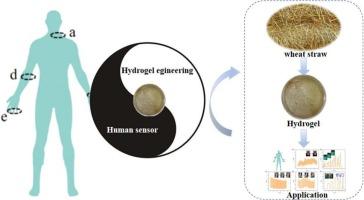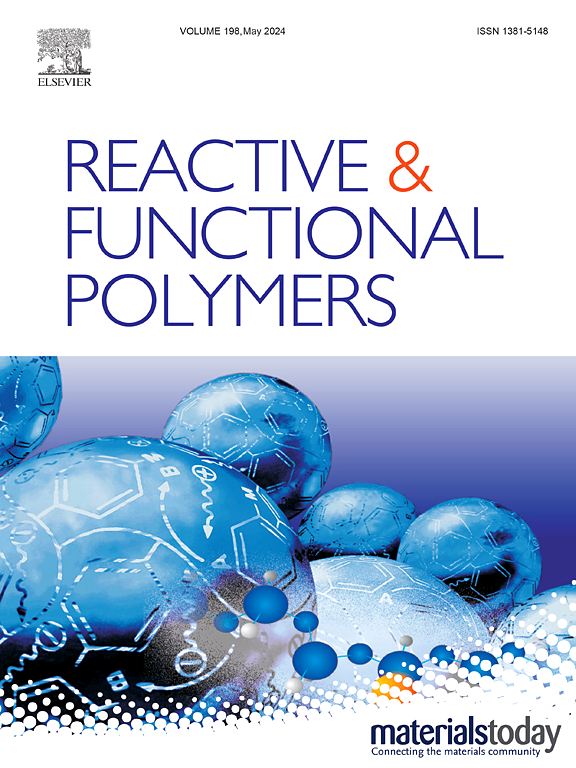Preparation of cellulose-based three-network ionic gel and its application in human sensor
IF 4.5
3区 工程技术
Q1 CHEMISTRY, APPLIED
引用次数: 0
Abstract
A lignin-embedded nanocellulose (LCNC) hydrogel, derived from repurposed wheat straw biomass, was fabricated through a ZnCl2-mediated soaking process. This innovative hydrogel leverages acrylamide/acrylic acid (AM/AA) monomers as a polymerizable deep eutectic solvent (PDES), enhancing its structural integrity. Notably, the hydrogel exhibits remarkable properties, including a minimal water loss rate of less than 5 %, a peak compressive stress of 0.28 MPa, Young's modulus of 0.015 MPa, a minimum impedance of 500 Ω, and an impressive conductivity of 8.0 × 10−4 S/m. Furthermore, when integrated into a sensor, it demonstrates a sensitivity factor (GF) of 0.08 KPa−1. Selecting this advanced hydrogel as the foundation for a piezoresistive stress sensor, we investigated its capability to detect subtle bodily motions. Our findings underscore the sensor's remarkable versatility; it not only promptly registers significant arm and wrist movements but also meticulously captures delicate throat movements during swallowing, finger flexion, and even the weight distribution when gripping heavier objects. This (PAM-PAA)/LCNC/SA-Zn2+ hydrogel-based sensor holds immense potential for many applications, including wearable technology, smart devices, health monitoring systems, and human motion recognition platforms. Its ability to accurately track and interpret a range of bodily movements and pressures underscores its significance in advancing the field of personal health tracking and interactive technologies.

纤维素基三网络离子凝胶的制备及其在人体传感器中的应用
摘要 一种木质素嵌入纳米纤维素(LCNC)水凝胶通过氯化锌(ZnCl2)介导的浸泡工艺制作而成,这种水凝胶来源于重新利用的小麦秸秆生物质。这种创新型水凝胶利用丙烯酰胺/丙烯酸(AM/AA)单体作为可聚合深共晶溶剂(PDES),增强了其结构完整性。值得注意的是,这种水凝胶具有卓越的性能,包括最小失水率小于 5%、峰值压缩应力为 0.28 兆帕、杨氏模量为 0.015 兆帕、最小阻抗为 500 Ω 以及令人印象深刻的导电率 8.0 × 10-4 S/m。此外,在集成到传感器中时,它的灵敏度系数(GF)为 0.08 KPa-1。选择这种先进的水凝胶作为压阻应力传感器的基础,我们研究了它检测身体细微运动的能力。我们的研究结果表明,这种传感器具有显著的多功能性;它不仅能及时记录手臂和手腕的重要运动,还能细致捕捉吞咽时喉咙的细微动作、手指的弯曲,甚至是抓握较重物体时的重量分布。这种基于(PAM-PAA)/LCNC/SA-Zn2+ 水凝胶的传感器在可穿戴技术、智能设备、健康监测系统和人体运动识别平台等许多应用领域都具有巨大潜力。它能够准确跟踪和解释一系列身体动作和压力,这突出表明了它在推进个人健康跟踪和互动技术领域的重要意义。
本文章由计算机程序翻译,如有差异,请以英文原文为准。
求助全文
约1分钟内获得全文
求助全文
来源期刊

Reactive & Functional Polymers
工程技术-高分子科学
CiteScore
8.90
自引率
5.90%
发文量
259
审稿时长
27 days
期刊介绍:
Reactive & Functional Polymers provides a forum to disseminate original ideas, concepts and developments in the science and technology of polymers with functional groups, which impart specific chemical reactivity or physical, chemical, structural, biological, and pharmacological functionality. The scope covers organic polymers, acting for instance as reagents, catalysts, templates, ion-exchangers, selective sorbents, chelating or antimicrobial agents, drug carriers, sensors, membranes, and hydrogels. This also includes reactive cross-linkable prepolymers and high-performance thermosetting polymers, natural or degradable polymers, conducting polymers, and porous polymers.
Original research articles must contain thorough molecular and material characterization data on synthesis of the above polymers in combination with their applications. Applications include but are not limited to catalysis, water or effluent treatment, separations and recovery, electronics and information storage, energy conversion, encapsulation, or adhesion.
 求助内容:
求助内容: 应助结果提醒方式:
应助结果提醒方式:


